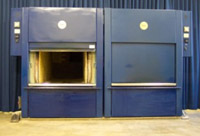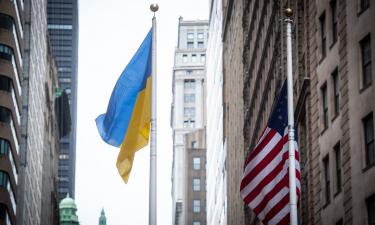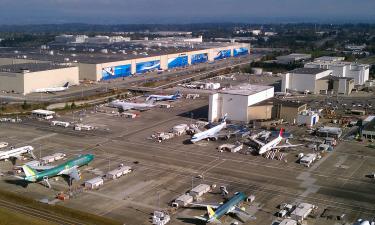Cremation business can make the living for those who like to burn the dead
In Russia, cremation is still an exotic while the traditional burial on cemeteries seems to be posing more threat to the environment. This is a really sad issue to discuss when you are alive and healthy, but any of us will one day have to answer if he wants to be buried in a traditional way but cremated. In the nearest future Russia will get a network of unique cremation complexes. Today, there are just few crematoria in the whole of the country which means that cremation is unavailable for all. Director of the Ritual Culture Institute at the Moscow State Academy of Governmental and Municipal Administration Yaroslav Baransky says that at the time when there are about 15,000 crematoria worldwide only 13 of them are based in Russia. Four of the thirteen are located in Moscow and the rest are in just few big cities.

Nowadays, the territories of cemeteries in Russia are terribly expanding: 61,000 cemeteries occupy the territory of 3.7 million hectares. This almost equals the territory of entire Switzerland! But the existing cemeteries are not enough, and people have to find more and more territories that can be assigned for making cemeteries. Experts state that existing cemeteries pose a real threat to people’s life. Yaroslav Baransky says that buried dead bodies absolutely mineralize in 13-16 years in the well ventilated sandy ground. He adds that when cemeteries are made on the watered ground there is high risk that chemicals used for the shock therapy of cancer deceased people or infections that caused death to some of the dead may easily get into the underground water. When cemeteries are made on the clay soil decomposition of dead bodies will be slow and take too much time. In case of exhumation in several decades there is much risk that very dangerous microbes may spread from such a grave. Experts believe that this fact explains why in the modern life some old diseased that we think to be extirpated may suddenly break out. In this case, cremation seems to be the only solution. Now, the RF Ministry for Health Care and Social Development is considering a list of diseases demanding obligatory cremation in case these diseases turn out to be lethal for patients.
The Donskoy crematorium based on the territory of Moscow’s Donskoy Cemetery was the first that was built in Russia in 1927. Atheistic Bolsheviks and ardent revolutionists were its first ‘clients’. It is closed now. The rest three crematoria based in Moscow make about 50,000 cremations a year. About 110,000 dead bodies are cremated in Russia in general today, which makes up only 6 percent of the total number of the deceased.
It is expected that in the nearest future one of the fifth deceased will be cremated. Modern cremation complexes with mourning halls will soon appear in large cities; more unique cremation complexes will be built in smaller cities. Experts of the Ritual Culture Institute explain that such complexes will be 50-100km equidistant from cities, villages and other settlements. They may be built on the territories of existing cemeteries. The temperature in furnaces will reach 1,100 centigrade degrees, and it will take an hour to burn down all organic components. At that, it is known that cremation of those who died of cancer takes half an hour more.
Producers of cremation furnaces now make different classes aggregates, heavy, middle class and light.
Director of a company making cremation aggregates Nikolay Zhukov says that furnaces able to stand up to 100 cremations a week are so huge that can be assembled right on the spot in large crematoria only. Middle and light class furnaces weighing 19 and 12 tons are meant for smaller towns where they can be delivered by trailer. Light class furnaces can work just for 2-3 hours a day.
After cremation and additional milling the remains will make up 2-2.5 liters and their particles willbe not bigger than granulated sugar that agrees with the world standard. At that, remains of a dead body after cremation contain no organic components and thus can pose no ecological disaster.
It is expected that modern cremation complexes will also have sections for burning dead animals and organs amputated or excised after surgery. Today, hundreds of thousands of tons of medical waste, including particularly dangerous, are just buried into the ground. God knows what terrible disasters this utilization method may bring.
The authors of the new unique cremation complexes hope that in the nearest future majority of Russians will consider cremation a really natural way of burial.
Construction of more cremation complexes is also important from the economic point of view. Cremation is several times cheaper than traditional burial. According to approximate estimates, cremation in new complexes will cost about one thousand rubles (less than $40). And a site in a columbarium will be twice as cheaper than a cemetery sector. Today, cremation in Moscow costs 1,500-1,600 rubles ($50-60), the cost of a burial urn not included. Crematoria offer from ordinary urns for 150 rubles to exclusive handmade ones that may cost $1-2,000.
Recent opinion polls reveal that majority of Russians, 65 percent, want or at least do not mind to be cremated. It means the mournful business of cremation will be soon in a great demand.
It is known that ninety percent of the deceased are cremated in South Korea. In the US, burial into the ground costs $15,000 while cremation costs not a cent, and the spending on the procedure is covered by the government. In Japan, not less than 99 percent of the deceased are cremated. Cremation is also widespread in Western, Northern and Eastern Europe.
The cremation tradition is different in all countries. In Russia, relatives of the dead choose for cremation cheap coffins for 1,000 rubles ($30-40) as well as super-expensive ones that may cost about $30,000. This is the reason why Russia has the world’s biggest cremation furnace more than a meter wide that can admit very big coffins. In the US, dead bodies are taken out of expensive oak coffins right after a mourning ceremony and put into narrow and cheap cardboard coffins meant especially for cremation. After disinfection, expensive oak coffins are often used again. In Germany, coffins must correspond to the standard width of 770 millimeter to be placed into cremation ovens.
Various religions have different views upon cremation. Among Catholics it was allowed in 1963, but the traditional burial into the ground is still preferable. At that, cremation urns cannot be taken to churches. Ashes after cremation are not scattered and not recommended for keeping at home. As for Protestants, cremation was allowed in 1898, and it is as frequent as with Catholics. Pastors come to crematoria to attend the ceremony. In the mid-1990s, the Patriarch of Moscow and All Russia Alexy II recognized that cremation could be allowed for Orthodox believers in some cases. Today, in crematoria in Russia priests read the burial service before cremation. While Jew religious authorities do not recognize cremation, it is still popular among progressive Jews. Moslems strongly protest against cremation as burning the body contradicts the Islam laws. Buddhists and Hinduists think that burning the body is important as it relieves the soul of a dead man of his physical body. Followers of the Shinto religion usually cremate dead people, keep their ashes in shrines at home and worship them up to 99 percent of followers of the religion are cremated.
Moskovsky Komsomolets
Translated by Maria Gousseva
Pravda.Ru
Discuss this article on Pravda.Ru English Forum
Subscribe to Pravda.Ru Telegram channel, Facebook, RSS!




